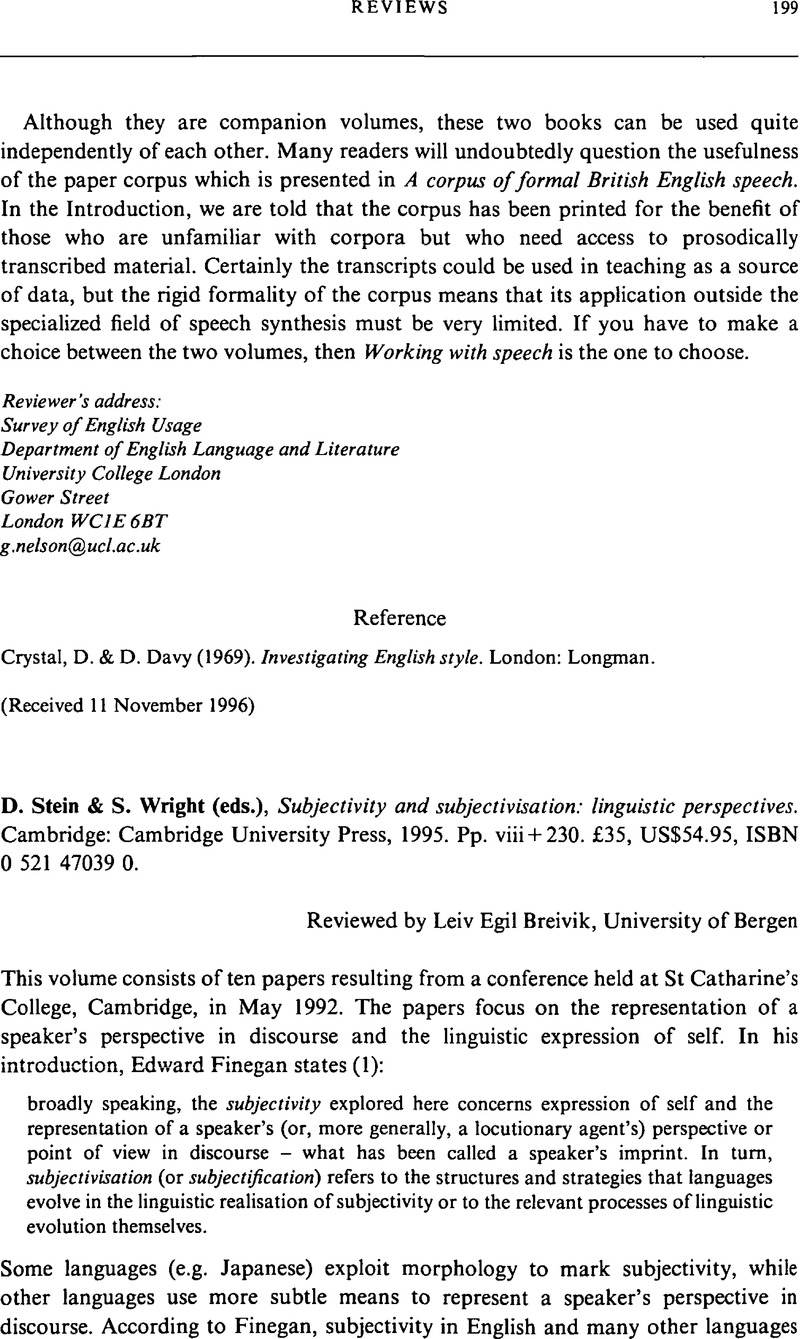No CrossRef data available.
Article contents
D. Stein & S. Wright (eds.), Subjectivity and subjectivisation: linguistic perspectives. Cambridge: Cambridge University Press, 1995. Pp. viii + 230. £35, US$54.95, ISBN 0 521 47039 0.
Published online by Cambridge University Press: 12 September 2008
Abstract
An abstract is not available for this content so a preview has been provided. Please use the Get access link above for information on how to access this content.

- Type
- Reviews
- Information
- Copyright
- Copyright © Cambridge University Press 1997
References
Breivik, L. E. (1989). On the causes of syntactic change in English. In Breivik, L. E. & Jahr, E. H. (eds.), Language change: contributions to the study of its causes. Berlin and New York: Mouton de Gruyter. 29–70.CrossRefGoogle Scholar
Hartvigson, H. H. & Jakobsen, L. K. (1974). Inversion in present-day English. Odense: Odense University Press.Google Scholar
Hopper, P. J. & Traugott, E. C. (1993). Grammaticalization. Cambridge: Cambridge University Press.Google Scholar
Jacobsson, B. (1951). Inversion in English with special reference to the Early Modern English Period. Uppsala: Almqvist and Wiksells Boktryckeri.Google Scholar
Kohonen, V. (1978). On the development of English word order in religious prose around 1000 and 1200: a quantitative study of word order in context. Åbo: Åbo Akademi Foundation.Google Scholar
Langacker, R. W. (1985). Observations and speculations on subjectivity. In Haiman, J. (ed.), Iconicity in syntax. Amsterdam: John Benjamins. 109–50.CrossRefGoogle Scholar
Langacker, R. W. (1993a). Universals of construal. In Guenter, J. S., Kaiser, B. A., & Zoll, C. C. (eds.), Proceedings of the nineteenth Annual Meeting of the Berkeley Linguistics Society. Berkeley: Berkeley Linguistics Society. 447–63.Google Scholar
Langacker, R. W. (1993b). Reference point construction. Cognitive Linguistics 4: 1–38.Google Scholar
Traugott, E. C. (1982). From propositional to textual and expressive meanings: some semantic–pragmatic aspects of grammaticalization. In Lehmann, W. P. & Malkiel, Y. (eds.), Perspectives on historical linguistics. Amsterdam: John Benjamins. 245–71.Google Scholar
Traugott, E. C. (1987). Literacy and language change: the special case of speech act verbs. In Langer, J. (ed.), Language, literacy, and culture: issues of society and schooling. Norwood, NJ: Ablex. 11–27.Google Scholar
Traugott, E. C. (1989). On the rise of epistemic meanings in English: an example of subjectification in semantic change. Language 65: 31–55.CrossRefGoogle Scholar
Traugott, E. C. & Dasher, R. (1987). On the historical relation between mental and speech act verbs in English and Japanese. In Ramat, A. G., Carrunba, O., & Bernini, G. (eds.), Papers from the seventh International Conference on Historical Linguistics. Amsterdam: John Benjamins. 561–73.Google Scholar
Traugott, E. C. & König, E. (1991). The semantics–pragmatics of grammaticalization revisited. In Traugott, E. C. & Heine, B. (eds.), Approaches to grammaticalization. 2 vols. Amsterdam: John Benjamins. 189–218.Google Scholar




